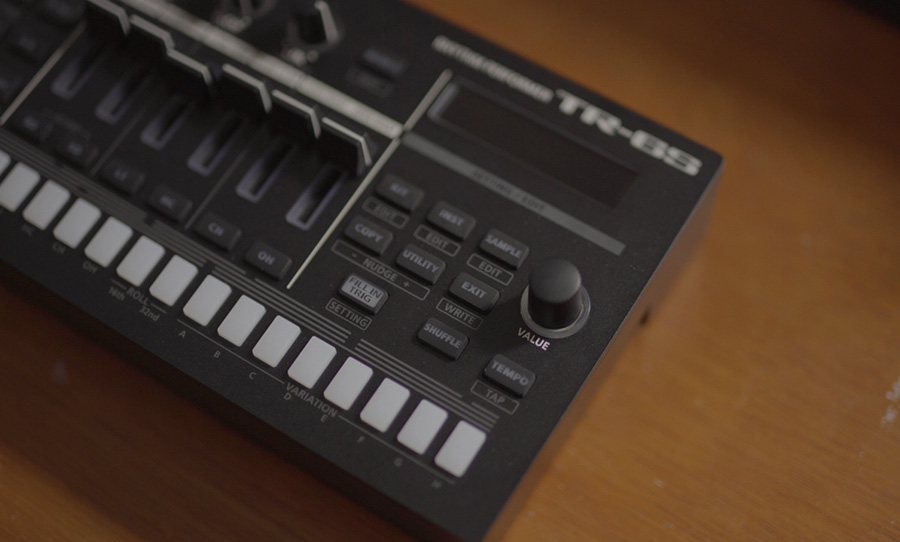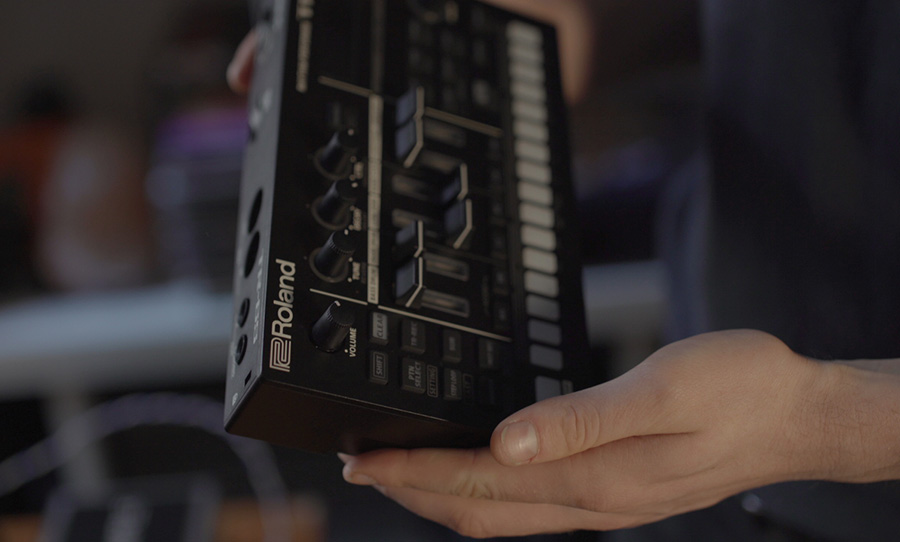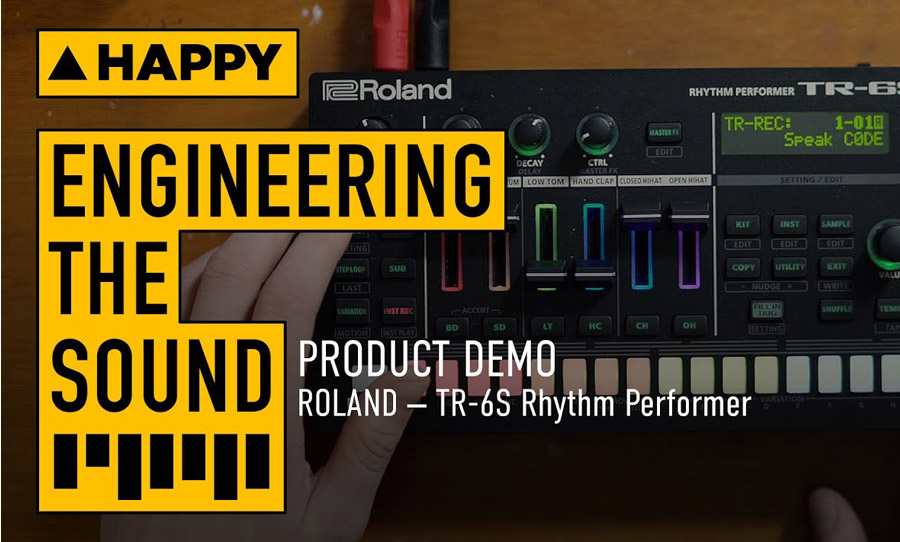A little brother to Roland’s flagship TR-8S Rhythm Performer, the TR-6S packs a hell of a punch despite the smaller size (and price tag). Engineering the Sound investigates.
Whether or not you’re comparing it to the hugely popular TR-8S, the Roland TR-6S Rhythm Performer is a damn powerful drum machine. A cheaper, smaller, and battery-powered alternative, it hits a nerve that live performers, home producers, and hobbyists alike will eat up. Here at Engineering the Sound, we were keen to put it through its paces.
Straight out of the box, this thing is portable, highly usable, and sounds great. The learning curve is one of the shortest you’ll experience in the land of drum machines; the individual track faders and the overall layout make for a very intuitive user experience. Anyone who’s familiar with mixers, such as DJs, live sound engineers, or live electronic artists, will have an especially easy time navigating the TR-6S.
So apart from being easy to pick up straight out of the box, what else makes TR-6S Rhythm Performer special? Let’s dive right in.
TR-6S versus TR-8S, what are the differences?
It’s a fact of product design that you can’t make something four times smaller without sacrificing a feature or two. But limitation breeds creativity, and though the TR-6S drops a few features you’ll find on it’s bigger brother, the downsizing has forced this machine’s creators into some excellent design decisions.
A fundamental difference is that the TR-6S has just six tracks, where the TR-8S has 11, meaning you lose out on dedicated channels for your Low, Mid, and High Toms, Rim Shot, Ride and Crash Cymbals. However all the samples are retained in the TR-6S library, so if you want to assign any toms to your beat, you’re still able to.
If anything, it forces you to be a little more creative with your sample selections. Plus as a longtime TR-8S user, I’ve rarely only utilised all 11 tracks in meaningful ways on a handful of sessions.
The Shift function becomes a lot more important on the TR-6S, given that the buttons have been trimmed down. For instance your variable Tune, Decay, and Control knobs can also control your Reverb, Delay, and Master FX with a press of the Shift button.
One straight upgrade from the TR-8S is the ability to click your main Value knob, meaning you’ll never have to press an Enter button again.

Live expression tools have also become more accessible, with the Step Loop, Motion, Sub, and Fill buttons holding a more prominent position on the interface. Jamming on the TR-8S was already a pleasure, but the TR-6S ensures the most powerful performance tools are always at your fingertips (and not behind any menus).
The back panel is another serious point of difference. Where the TR-8S had a wealth of input, output, and trigger options, the TR-6S takes a more minimal approach. Aside from the main output, you have a MIDI in/out as well as a USB input, meaning the 6S is perfect for smaller setups. If you’re wanting to keep a drum machine as the brains of your studio, you should still consider pricing up to the 8S.
USB audio functions the same as the External In on the 8S, meaning you can apply any of the onboard TR-6S FX to audio coming from your DAW, mixer, or instrument with a USB out. Want to sidechain audio from your laptop, or apply some delay to an external instrument? You can still do it on a TR-6S.
Where the TR-6S will truly shine is on a battery-powered setup – unlike the TR-8S, you can go portable with several hours of playing time. Playing a live set in an outdoor or less-than-legal location? Hook this up to the rest of your setup, jam it in a travel case, and never worry about finding a power socket again.

Diving deeper
The further you delve below the surface-level features of the TR-6S, the more incredible a machine it becomes. Under the hood you’ll find a wealth of performance and sound design tools – I hate to use the term ‘infinite possibilities’, but it’s quite applicable in this case.
The FM engine allows for a huge amount of control over your samples and instruments, allowing editing of the attack, decay, pitch, FX, and more down to an infinitesimal level. Each track can be designed to react differently to your master reverb, delay, and FX, meaning if you only want your delay on hi-hats but not on your kick, you can have it.
Motion recording can also be applied to tracks individually. When paired with the FM engine and the various synth, bass, chord, and FX sounds in the TR-6S library, recording motion across the pitch parameter allows you to actually program melodies into your beats. Turn a stabbing, repetitive note into a sequenced bass line for a massive crowd moment, or program your own chord progressions into 4-bar sequences to elevate the 6S far beyond the capabilities of other drum machines.
The onboard FX provide more than enough room to play, including EQs and filters, reverb, delay, compressors, drive, distortion, a crusher, saturator, frequency shifter, and ring mod, plus a few variations and combinations thereof. Get fancy by programming different LFOs on your tracks, creating complex interactions and the ability to dig for never-before-heard sounds.
The Fill function can also be taken as far as you’d like – choose between programming your own fills or 10 different Scatter programs to create easy-to-access transitions or to add that much-needed variation to your beats. Fills can also be programmed to run automatically every 2, 4, 8, 16, or 32 bars – you’ll never scold yourself for forgetting to hit that trigger again.
Each Scatter type can be scaled from a Depth of 1 to 10, starting non-intrusive but growing into mind-warping psychedelic fills. If you’re in the menu, you can even change the Scatter Depth mid-fill for some zany results.

Part of something bigger
So how does this beast of a drum machine fit into your existing setup? Despite only having a few input and output options, there’s a number of ways you could integrate the TR-6S.
A DAWless setup with a mixer is easy – plug in your outs and MIDI sync to your synth, more percussion, or other tools. If your other gear has USB audio (such as the Boutique series from Roland, for starters) it’s a huge plus, and you’ll be able to benefit from the USB Audio input on the 6S and the variety of performance tools it provides.
Add some TR-6S delay or reverb to open up your monosynth, or apply a compressor to give any outboard gear that extra punch. Another fun interaction comes via the Scatter fills, which also apply to any audio coming through the USB input.
A minimal setup with just a laptop and the TR-6S is also a killer option, again taking advantage of USB audio but also the ability to use your 6S as a MIDI controller. Feeling out drum programs on a TR-6S will always be easier than doing it in-the-box, and being able to easily migrate your beats into your DAW is a huge plus.
And fitting it into the studio? The huge sample library and the ease of creating new beats certainly come in handy, no matter what style of music you play. It’s up to you whether you use the TR-6S as a MIDI controller or you record straight into an interface – the point being that either is possible depending on your preference.

The verdict
When trimming down the TR-8S, Roland did anything but gut their iconic drum machine. The TR-6S is smaller and cheaper, yes, but it actually boasts a few features that its predecessor doesn’t. Battery power, an improved UX, and more accessible performance tools make the new toy a hugely enticing choice for live performers, and the boons for anyone seeking a mid-range drum machine are numerous.
After playing with the TR-6S for a few days and returning to my trusty 8S, I actually found myself missing a few features from the TR-6S – and that should tell you everything you need to know. This little unit is fun as hell and definitely gets the Engineering the Sound tick of approval.
Find out more about the Roland TR-6S here.



